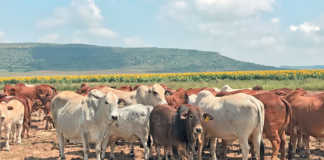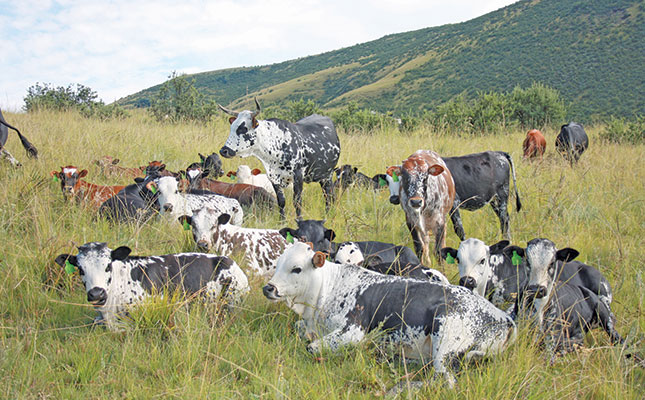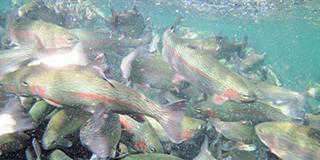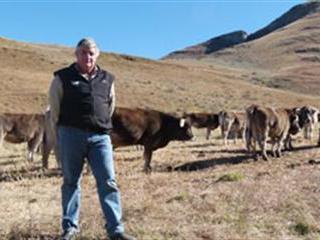
Gawie Naudé’s grandfather (also Gawie) introduced Braunvieh cattle to the 952ha Buttermead Farm near Rhodes in the Eastern Cape in 1935 because of the extreme weather conditions of this high altitude area. Because its origins are in the Alps, the Braunvieh has a higher red blood cell count than other breeds. This helps it to adapt easily to extreme cold and to extreme heat.
“The animals on our farm are exposed to extreme conditions and must handle themselves on the veld,” says Gawie, who these days farms with his son Willem. “Snow often falls in winter, and that’s probably why Oupa decided on Braunvieh.’’
However, Gawie is quick to point out that the modern Eduan Braunvieh is almost unrecognisable from the early cattle that were bred mainly for their milk production. “It’s a totally different animal. The breeding policy now is to breed hardy animals that can manage themselves and produce milk and meat. Performance and fertility are central in achieving this.”
Getting started
In 1935 Gawie Naudé Snr bought the first registered Braunvieh bull, Saxon Oberst, from the Von Maltitz brothers near Ficksburg. This was followed by the purchase of two Braunvieh cows – Fessie II and Hoop – from A van Jaarsveld and LJ van Zijl from the Burgersdorp district of the Eastern Cape. On 2 November, 1936, the first Braunvieh calf, Elands Height Nemo, was born on Buttermead and, in the same year, the Eduan Braunvieh Stud was registered.
In 1946 Gawie’s father Willem joined the Naudé farming operation and played a central role in expanding the herd by acquiring genetics from such well-known Braunvieh as Millard, Pitlochrie, Lizon and Vaaldu studs. Starting in the early 1970s, these efforts were bolstered by an artificial insemination programme that included semen from South African, Swiss and German Braunvieh bulls.
Changes
However, when Gawie Jnr returned to Buttermead in 1976 after a stint in the army and obtaining his BAgric at the University of the Free State, major changes where in store for the Eduan Braunvieh herd. For example, Gawie insisted that Eduan Braunvieh animals be shown and marketed beyond the local Rhodes and Barkly East districts. In 1981 the bull, Galant, was crowned the Junior Champion Braunvieh bull at the Bloemfontein and Pretoria shows.
In addition, Gawie realised the importance of selecting for beef production within the herd. So in the early 1980s commercial milking was stopped on Buttermead, and the Eduan Braunvieh cows were gradually transformed from large 700kg to 800kg animals to the current medium-framed cows of between 500kg to 550kg that are bred predominantly to produce beef. When it was decided to focus on beef production on Buttermead they farmed the cattle extensively on the veld (thereby minimising input costs).
Cows were run on the veld and had to fend for themselves in the mountains (as opposed to receiving extra feed including grazing on cultivated pastures as is the case in a dairy environment). To be able to utilise the veld effectively cows had to be medium framed not only to be able to move around the rough environment of the region in search of grazing but also to be able to sustain themselves on what the natural veld could offer.
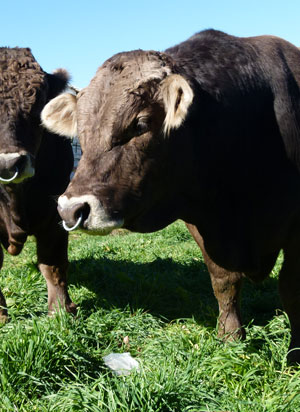
The 23-month- old bull Eduan Kanon. Four generations of the Naudé family have been involved in making the stud the success it is today. Photo by Mike burgess
Over time, the cows adapted to the demands of their ‘new’ environment and were selected to be medium framed (and not smaller) so as to survive on the veld while still being able to produce quality weaners. In the early years, Eduan Braunvieh cattle were predominantly milked from the veld. Now it’s all about producing quality weaners, explains Gawie. Performance testing plays a central role in the selection process, and Eduan Braunvieh bulls have excelled in central performance tests (Phase C) since the 1980s when, for example, the hugely influential bull, Sonneskyn Amanda’s Dufur the 3rd, produced numerous Phase C champions.
It’s a trend that continues to the present day, with the bulls Eduan Rilo’s Jafta and Eduan Bacardi’s Kalvyn being selected to represent the Braunvieh breed at the Vleissentraal-ARC Special Performance Test class in Pretoria in 2011 and 2012 respectively. Not surprisingly, then, only gold and silver merit Braunvieh bulls are used within the three to four single sire breeding herds on Buttermead. Some 50% of Braunvieh herd sires are home-bred while, since 2005, the balance has been purchased from the Northern Cape Vaaldu, Christopher and AC Cattle Co Braunvieh studs.
In demand
“The challenge is to always have the correct sire available,” explains Gawie. “I always say the stud farmer is a little bit mad: you have to have a long-term vision and you need to see that if you do this, then that will be the result.’’ Currently Eduan Braunvieh bulls are marketed at the Vryburg Show each year and from Buttermead farm throughout the year. In 2011/2012, 15 bulls were sold at an average price of R26 500 with a top price of R50 000.
According to Gawie, the demand for Eduan Braunvieh bulls remains high, especially among commercial cattlemen in search of quality bulls for cross-breeding purposes. Furthermore, because the Braunvieh complements the Brahman so well, when crossed, the vast majority of their commercial clients farm with Brahmans. “If they use a Braunvieh bull on the grey Brahman cow they get a uniform type and a uniform colour,” adds Gawie.
Managing females
Gawie stresses the importance of dam bloodlines in the success of the stud. “We have just had a look at our show animals this year and it basically boils down to two cows 30 to 40 years back – Eduan Winnie and Eduan Ysig,’’ he explains. “It’s very important to stick to bloodlines; it can’t be the sole factor for selection, but you always have, your bloodlines that produce better.”
Well aware of the genetic contribution of female animals within the Eduan and national Braunvieh herd, the Naudés not only make a point of purchasing female animals, they’ve also sold 15 females in 2011/2012, achieving top prices of R10 000 for a cow and calf in 2011 and R18 000 in 2012.
The average Eduan Braunvieh herd ICP is 402 days. Because of the Braunvieh’s very early maturity, heifers are mated once they reach 350kg, with 80% having achieved this weight at the age of 14 months in the current breeding season. Heifers are mated to calve from mid-August to mid-November, while cows are mated to calve from mid-September to mid-December. The only exception is the five cows that produce milk for consumption on the farm – they calve in autumn. All animals receive the standard phosphate lick in summer and a protein lick in winter. Female animals and calves also receive a protein backgrounding on the veld for six to eight weeks after calving to boost production.
Calving percentage
The Eduan Braunvieh herd boasts a calving percentage of over 93% for the past five years, while weaning weights at 22 weeks average at 250kg for bull calves (306kg at 205 days) and 238kg for heifer calves (280kg at 205 days). In fact, Braunvieh cows on Buttermead produce weaners that weigh more than 50% of their own weight on average – a fact that adequately illustrates just how well Eduan Braunvieh cows are now able to produce beef in the highlands of the Eastern Cape.
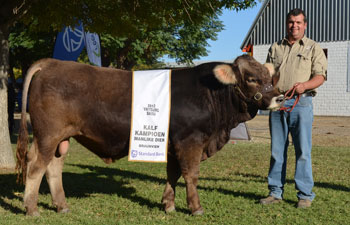
Success at the 2012 Vryburg Show
The Vryburg Show – the largest cattle show in South Africa – is not only an important marketing platform for Eduan Braunvieh cattle, but also a time to measure the stud’s competitiveness, says Gawie. “It’s always good to measure where you stand with your stud in the industry,’’ he explains. “You need to refresh and you need to update.”
Mainly juniorn Eduan Braunvieh cattle are transported to the show each year where they have always excelled, and 2012 has been no exception. For example, Eduan Bacardi’s Legend 75 was named the National Calf Champion Braunvieh Bull and Eduan Bacardi’s Kalvyn the National Reserve Junior Champion Braunvieh Bull. Kalvyn was also crowned the top Braunvieh Phase C Bull, the Interbreed Reserve Champion Phase C Bull, and selected to represent the Braunvieh breed at the Vleissentraal-ARC Special Performance Test class in Pretoria in 2012.
Contact Gawie Naudé on 082 897 9555 or visit www.eduan.co.za











